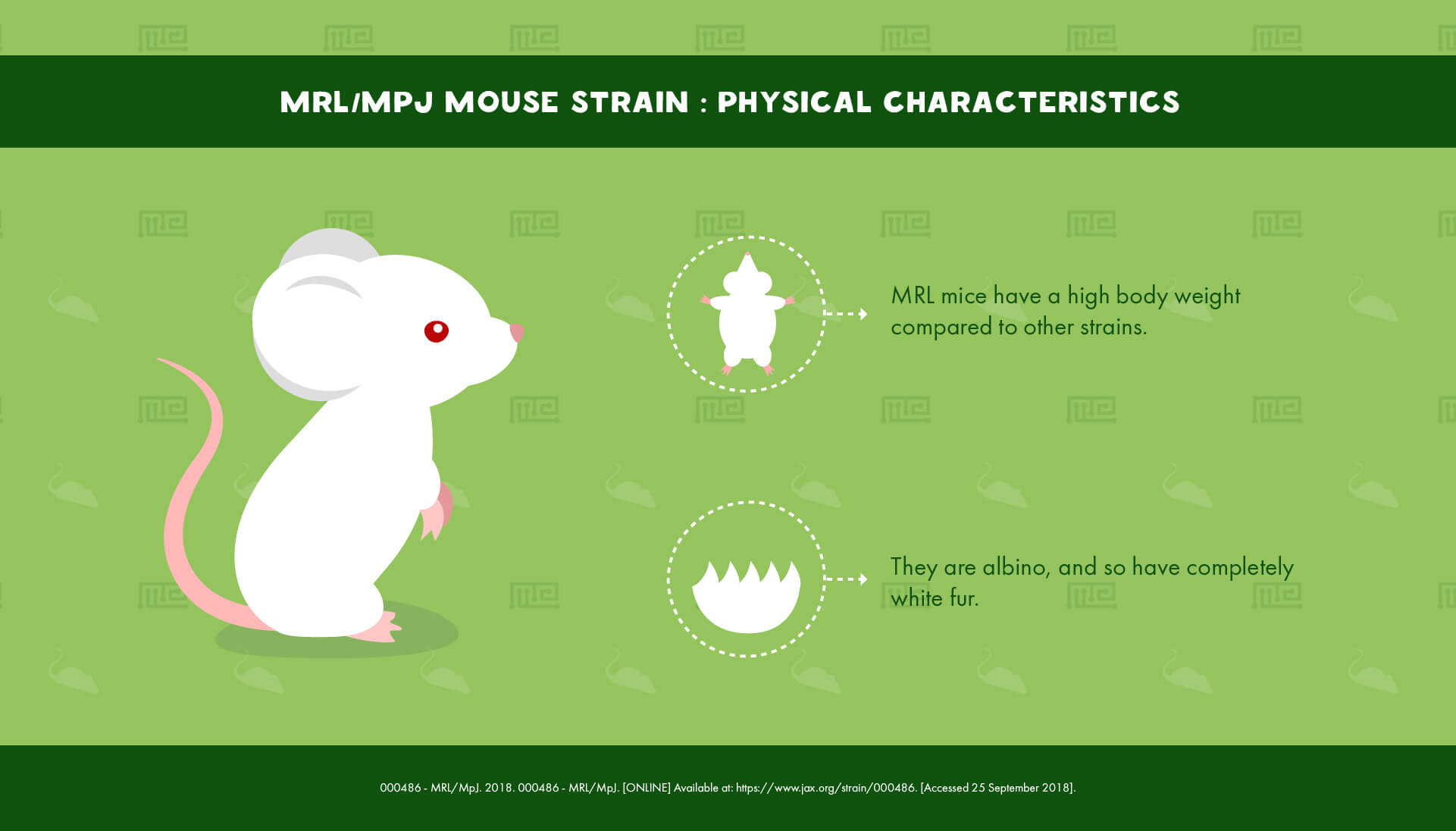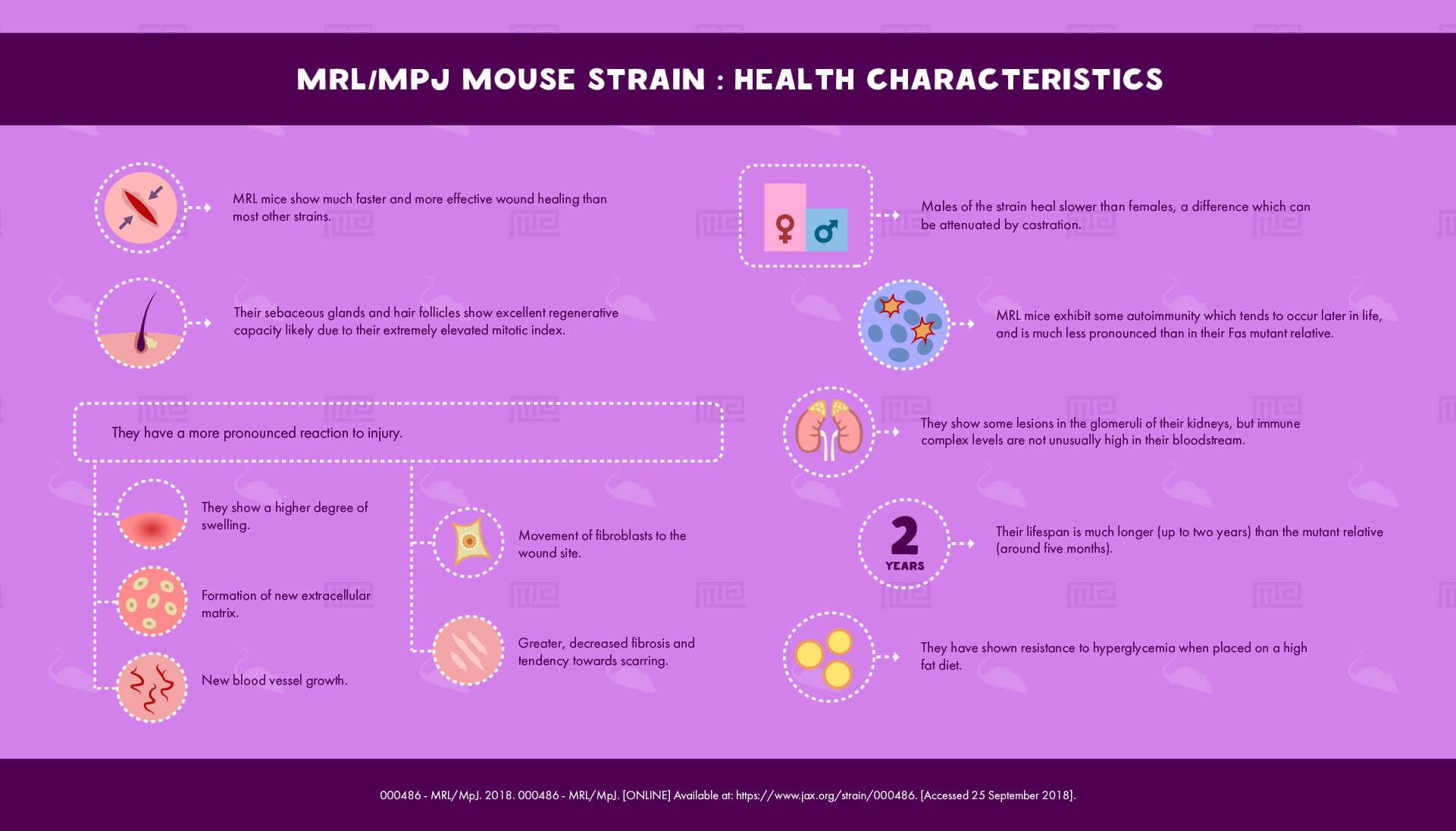Overview
The MRL mouse, also known as MRL/MpJ and Murphy Roths Large, is a strain of mouse model that is well known for its impressive tissue regeneration capabilities. It also acts as a wild-type control for the related mutant MRL/MpJ-Faslpr strain.[1]
History
The MRL strain is named after its creator E.D. Murphy who developed the strain in the 1960s. Murphy carried out crossbreeding, mixing together a number of strains including AKR/J, LG/J, C3H/HeDi and C57BL/6J, before moving on to inbreeding once the desired phenotype was established.
The key Faslpr mutation emerged after twelve generations. The mutant mice were then separated from the wild-type, to create two lineages. There have now been over 100 generations of the control MRL strain, whose congenicity is maintained by regular backcrossing.[1][2]
Physical Characteristics
As their name suggests, MRL mice have a high body weight compared to other strains. They are albino, and so have completely white fur.[1]
Behavioral Characteristics & Handling
This strain has been described as docile, with males showing minimal intra-strain aggression.[1] Detailed information on the handling of this strain could not be found in the literature, but reports of high docility are promising for researchers hoping for ease of handling.
MRL mice perform worse in the Morris water maze task of spatial memory than the commonly used C57BL/6J strain, as well as in the visual paired comparison task. This deficit was attributed to fewer neurons in the dentate gyrus of MRL. Interestingly, however, MRL mice showed a capacity to improve in these tasks that were not seen with the C57BL/6J.[3]
Health Characteristics
MRL mice show much faster and more effective wound healing than most other strains, a trait which was likely passed down to them from their LG/J ancestry.
After punching a hole of 2 mm diameter in the ear of both an MRL mouse and a C57BL/6J mouse at the same time, researchers observed that the ear of the MRL mouse had healed almost entirely after four weeks, whereas the C57BL/6 ear had healed less than 50%.[1]
The reaction of MRL mice to injury is much more pronounced than normal, with a higher degree of swelling, new blood vessel growth, the formation of a new extracellular matrix, and movement of fibroblasts to the wound site, as well as greater, decreased fibrosis and tendency towards scarring.
Their sebaceous glands and hair follicles also show excellent regenerative capacity, and the Jackson Laboratory reports that they show improved healing of damaged heart tissue. The excellent regeneration is likely due to their extremely elevated mitotic index, which is comparable to non-mammalian species.
Mapping of the MRL genome has identified several Heal genes associated with this phenotype on chromosomes 13, 12 and 8. Males of the strain heal slower than females, a difference which can be attenuated by castration.
MRL mice also exhibit some autoimmunity, which tends to occur later in life, and is much less pronounced than in their Fas mutant relative. They show some lesions in the glomeruli of their kidneys, but immune complex levels are not unusually high in their bloodstream.
Lifespan is much longer for this wild-type strain (up to two years) than the mutant relative (around five months). They have shown resistance to hyperglycemia when placed on a high-fat diet.[4]
Major Experimental Uses
MRL mice have proven of great interest to researchers in wound healing and tissue engineering over the past two decades. Traditionally, however, the strain has been used most frequently as a control for experiments with the mutant MRL/MpJ-Faslpr strain.[1]
As such a control, MRL mice find applications in the study of Sjogren syndrome, autoimmunity, arthritis, lupus erythematosus, and hearing defects.[1]
References
- 000486 – MRL/MpJ. 2018. 000486 – MRL/MpJ. [ONLINE] Available at: https://www.jax.org/strain/000486. [Accessed 25 September 2018].
- MGI – Inbred Strains: MRL. 2018. MGI – Inbred Strains: MRL. [ONLINE] Available at: http://www.informatics.jax.org/inbred_strains/mouse/docs/MRL.shtml#Murphy1981. [Accessed 25 September 2018].
- HEYDEMANN, A. (2012). The super super-healing MRL mouse strain. Frontiers in Biology, 7(6), 522–538.
- Mull, A. J., Berhanu, T. K., Roberts, N. W., & Heydemann, A. (2014). The Murphy Roths Large (MRL) mouse strain is naturally resistant to high-fat diet-induced hyperglycemia. Metabolism: Clinical and Experimental, 63(12), 1577–1586.


